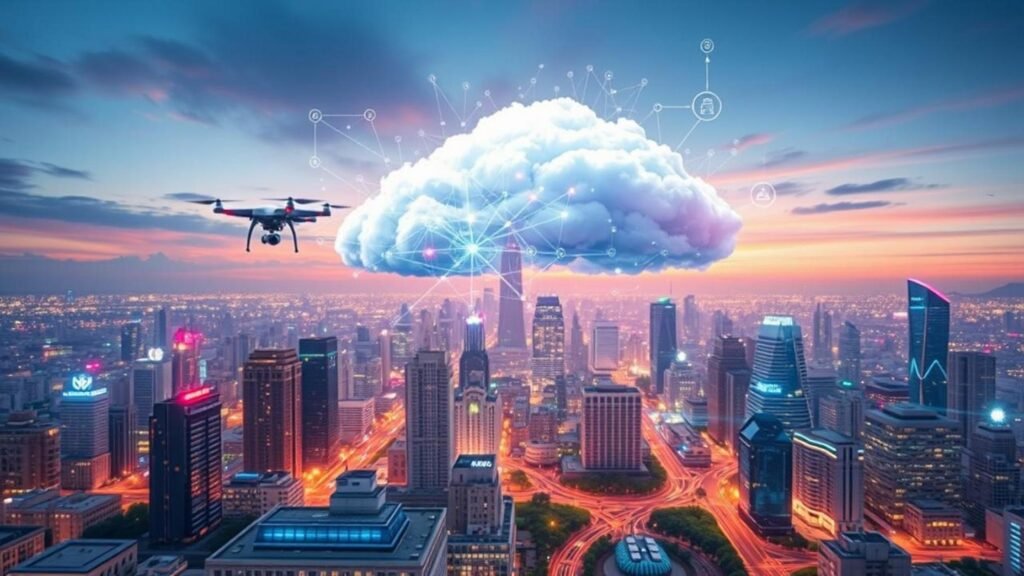Understanding Edge vs Cloud AI: An Overview of Technologies and Trends
As businesses increasingly seek to leverage artificial intelligence (AI) for operational efficiency, understanding the nuances of edge vs cloud AI becomes essential. Edge AI refers to the deployment of AI algorithms directly on devices at the network’s edge, allowing for real-time data processing and decision-making without relying on cloud connectivity. In contrast, cloud AI involves processing data in a centralized server environment, harnessing the power of expansive cloud infrastructure for computational tasks.
Defining Edge AI and Cloud AI
Edge AI processes data locally on devices such as smartphones, IoT sensors, and embedded systems. This architecture minimizes latency and bandwidth usage, making it ideal for applications requiring immediate response times. Use cases include autonomous vehicles, smart home devices, and real-time surveillance systems. On the flip side, cloud AI capitalizes on robust data centers to perform complex calculations and analytics, supporting applications that can handle delays in data transmission—for example, comprehensive data analysis for big data workloads and machine learning model training [Source: Towards Data Science].
Current Industry Trends
In recent years, we’ve observed a marked shift towards edge computing, driven by the need for instantaneous data processing and increased privacy concerns. According to a report from Gartner, by 2025, 75% of enterprise-generated data will be created outside of traditional centralized data centers. This trend aligns with the growing adoption of IoT devices, which generate vast amounts of data that require immediate processing.
Conversely, cloud AI remains relevant, particularly for organizations looking to leverage the scale and flexibility offered by cloud platforms. Many businesses are adopting a hybrid model, balancing both edge and cloud solutions to optimize their operations efficiently. As detailed in our article about AI tools for solopreneurs, integrating these solutions can provide a versatile framework that adapts to varying workload demands.
Cost Implications of Edge and Cloud AI
When analyzing the cost implications of edge business use cases, organizations must consider hardware expenses, ongoing maintenance, and potential savings from reduced bandwidth use. Although edge computing can require significant upfront investment, it often leads to lower operational costs in the long run by lessening reliance on cloud resources.
On the other hand, while cloud AI offers a more accessible entry point for organizations due to its pay-as-you-go pricing, ongoing subscription costs can accumulate, particularly for enterprises utilizing extensive data processing capabilities. The decision often hinges on the specific use case and the volume of data generated, indicating that businesses should carefully evaluate their unique needs and operational environments.
In summary, effectively navigating the edge vs cloud AI landscape requires understanding the defining characteristics, emerging trends, and associated costs of each platform. As organizations continue to innovate and expand their AI capabilities, this foundational knowledge will be key to making strategic decisions that align with their business goals.
Analyzing Edge Business Use Cases: Performance and Latency Benefits
In the ongoing debate of edge vs cloud AI, latency emerges as one of the most significant factors influencing performance across various industries. Edge AI processes data closer to its source, which drastically reduces the time it takes to generate insights. This characteristic makes it increasingly relevant for applications where speed is paramount, such as real-time analytics in manufacturing, autonomous driving, and health monitoring systems.
Key Applications of Edge AI
- Manufacturing and Industrial Automation – In manufacturing, edge devices can analyze machinery performance in real-time, enabling predictive maintenance. Companies like Siemens have successfully implemented edge AI for equipment monitoring, significantly reducing downtime and improving operational efficiency [Source: Siemens].
- Healthcare Monitoring – In healthcare, wearable devices equipped with edge computing capabilities help in monitoring patients’ vital signs in real-time, allowing for immediate responses to critical changes. The use of edge AI in remote patient monitoring has demonstrated substantial improvements in patient outcomes and significant cost savings for healthcare providers [Source: NIH].
- Autonomous Vehicles – A quintessential example of utilizing edge AI is in the realm of autonomous vehicles, where real-time data processing is crucial for making immediate decisions, such as avoiding obstacles and navigating complex environments. Companies like Tesla leverage edge processing to enhance vehicle safety through swift data analysis and decision-making.
The Impact of Latency on Performance
Latency plays a crucial role in determining the effectiveness of AI applications. High latency can result in delayed data processing, which is detrimental in time-sensitive scenarios. Edge computing reduces latency by minimizing the distance data must travel to be analyzed. For example, applications in finance rely on low-latency systems to perform high-frequency trading where every microsecond counts [Source: Forbes].
ROI Examples from Successful Edge Implementations
Numerous companies are already reaping the benefits of deploying edge AI over traditional cloud-based systems. A notable example is a retail chain that integrated edge devices into their inventory management system, achieving a 30% increase in operational efficiency and a 15% reduction in stock discrepancies [Source: ResearchGate].
Furthermore, a logistics firm utilizing edge-computing solutions reported enhanced tracking capabilities, resulting in improved delivery times and customer satisfaction metrics. The introduction of this technology led to a reported ROI of 200% within the first two years of deployment [Source: McKinsey].
With the growing number of successful edge business use cases, it is clear that edge AI not only competes with cloud solutions but often surpasses them in application areas requiring real-time processing and high reliability.
Evaluating Cloud AI Solutions: Scale, Accessibility, and Cost Efficiency
When considering the deployment of Artificial Intelligence, enterprises are often faced with the choice between cloud AI and edge AI. While edge solutions offer localized processing for minimal latency, cloud AI solutions shine in terms of scale, accessibility, and cost efficiency.
Scale and Accessibility of Cloud AI
One of the most compelling advantages of cloud AI is its scalability. Businesses can leverage vast computing resources offered by cloud providers, accommodating fluctuating workloads without any significant upfront investment in on-premises infrastructure. Platforms like Amazon Web Services and Google Cloud provide a plethora of AI services that can be accessed on a pay-as-you-go model [Source: Google Cloud].
This accessibility fosters innovation; businesses can quickly experiment with new AI models and applications without being hindered by hardware limitations. A case study from [Source: Towards Data Science] reveals how a rural healthcare provider utilized cloud AI to analyze patient data in real-time, significantly improving health outcomes and operational efficiency.
Cost Efficiency of Cloud Solutions
Cost efficiency is another crucial factor that leans enterprises towards cloud AI. By outsourcing computing resources, businesses can convert fixed costs into variable costs, eliminating the need to maintain large data centers. For example, a manufacturing firm adopted cloud AI for predictive maintenance, resulting in reduced downtime and extending the lifespan of machinery, leading to a [Source: McKinsey] reduction in equipment failure by 20%.
Latency Considerations: Edge vs Cloud AI
While cloud AI presents many strengths, latency is a critical factor businesses must consider. Edge AI provides lower latency by processing data closer to where it is generated. However, for many applications that don’t require immediate processing, the minimal latency in cloud AI becomes less of a concern. As bandwidth and network infrastructure improve, the gap in latency may continue to close, allowing cloud solutions to compete more effectively with edge alternatives.
In conclusion, while edge AI has its unique advantages, cloud AI solutions effectively address challenges of scalability and cost efficiency. By leveraging cloud capabilities, enterprises can unlock the potential of AI in a way that fosters growth, innovation, and significant ROI, essential for navigating the competitive landscape of 2025.
Cost Comparison: Edge vs Cloud AI in 2025
The cost dynamics between edge and cloud AI solutions are crucial for businesses considering their technology investments by 2025. As AI becomes increasingly integrated into various industries, understanding the infrastructure and operational costs associated with each deployment model will inform strategic decisions.
Infrastructure Costs
In the edge vs cloud AI debate, infrastructure costs represent a significant differentiator. Edge AI systems typically require localized hardware, such as GPUs or other specialized chips installed near data sources. This might be a higher upfront cost, but can lead to long-term savings, particularly in scenarios where latency or real-time processing is critical [Source: Gartner].
Conversely, cloud AI models operate on a pay-as-you-go basis, significantly lowering initial investment requirements. However, ongoing expenses may accrue as businesses scale their data processing needs. Estimates suggest that these costs can escalate, particularly for data-intensive applications [Source: Forbes].
Operational Costs and ROI
Operational costs go hand-in-hand with infrastructure choices. Edge AI can reduce data transfer costs since less information is sent to the cloud, lowering expenses tied to bandwidth usage. Furthermore, many edge deployments function offline or with minimal connectivity, vital in industries like manufacturing or healthcare [Source: IBM].
On the other hand, cloud AI offers operational ease; businesses can focus on leveraging AI capabilities without worrying about hardware upgrades. This ease often boosts productivity, though variable pricing can lead to budgeting challenges.
In conclusion, the choice between edge and cloud AI solutions in 2025 hinges on detailed cost considerations. While edge computing presents higher upfront costs, the long-term benefits related to operational efficiency and reduced bandwidth expenses could offer compelling advantages.
Strategic Recommendations: Choosing Between Edge and Cloud AI
Navigating the landscape of AI deployment can be complex, particularly when weighing the options of edge versus cloud AI. Here are some strategic recommendations to guide your decision-making process, focusing on key factors such as latency, operational efficiency, and return on investment (ROI).
Key Factors to Consider in Edge vs Cloud AI
- Latency Requirements – Applications necessitating real-time processing, such as autonomous vehicles or live video analytics, must prioritize edge AI technologies. Deploying AI solutions on-device reduces latency, essential for applications where timing is critical.
- Data Sensitivity – Consider the nature of the data processed. For applications requiring compliance with regulations, like healthcare and finance, edge AI offers a more secure solution, minimizing potential security breaches.
- Connectivity and Bandwidth – In scenarios where bandwidth is limited, edge AI solutions minimize the need for constant connectivity to a central server, pivotal in remote areas.
- Scalability Needs – Factor in the scalability of your chosen solution. Cloud AI typically provides extensive resources without the necessity for physical upgrades, while edge AI might incur higher upfront costs.
Latency Analysis for Informed Decision-Making
The importance of conducting a thorough latency analysis cannot be overstated. Applications supporting critical operations not only require low latency but benefit from a reliable and efficient AI model. Businesses should evaluate their specific latency needs and conduct tests to assess performance in their unique environments.
Maximizing Business Value: ROI Examples
Understanding the return on investment from edge and cloud implementations provides a tangible basis for decision-making. Recent case studies illustrate how businesses in logistics and inventory management adopted edge AI, leading to decreased operational costs and enhanced efficiency, with some reporting ROI improvements of over 30% within the first year.
Ultimately, the choice between edge and cloud AI should be tailored to the specific use case, considering factors such as latency, compliance, scalability, and ROI. Investing time in understanding these elements can yield substantial dividends, maximizing your business’s value in the evolving digital landscape.
Sources
- Google Cloud – AI Platform Documentation
- Towards Data Science – A Comprehensive Overview of Edge AI
- Towards Data Science – Benefits of Cloud Computing in Rural Area Healthcare
- Forbes – What is Edge Computing and Why Do You Need It?
- Gartner – Insights on Edge Computing
- IBM – Edge Computing
- McKinsey – Health Monitoring in Manufacturing
- McKinsey – The Future of Logistics
- NIH – Remote Patient Monitoring
- ResearchGate – Adoption of Edge Computing Applications in Retail
- Siemens – Edge Computing Solutions



